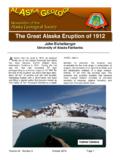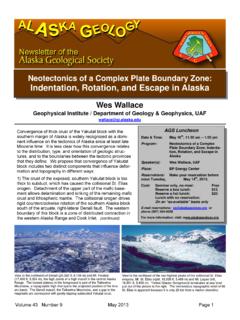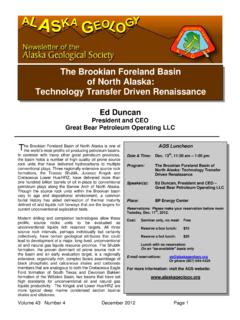Transcription of The Application of LiDAR (Light Detection And …
1 Volume 42 Number 6 February 2012 Page 1 AGS Luncheon Date & Time: Feb. 16th, 11:30 am 1:00 pm Program: Application of LiDAR Technology Speaker(s): Peter P. Flaig Place: BP Energy Center Reservations: Please make your reservation before noon Tuesday, Feb. 14th, 2012. Cost: Seminar only, no meal: Free Reserve a box lunch: $15 Reserve a hot lunch: $20 Lunch with no reservation: On an as-available basis only E-mail reservations: Or phone (907) 644-4429 For more information: visit the AGS website: Peter P. Flaig1, Dolores A. van der Kolk1, Richard Garrard2, Darrin Burton1, and Lesli Wood1, 1 University of Texas at Austin, bureau of Economic Geology, Quantitative Clastics Laboratory 2 FEX , Anchorage, AlaskaLiDAR (Light Detection And Ranging) is a non-invasive, remote sensing technique that allows for rapid collection of large, 3-dimensional outcrop datasets with intrinsic qualities that include quantitative relationships and potential proxies for lithology.
2 LiDAR is principally RADAR that uses light rather than sound waves to collect spatially referenced point clouds at ~2500 samples per second at a range of up to 800 m (ground-based LiDAR ). Point clouds are rendered and analyzed in InnovMetrics 3-D metrology software Polyworks. The Quantitative Clastics Laboratory at the Bureau of Economic Geology, University of Texas at Austin curates a LiDAR Legacy dataset that now includes a recent survey recorded from Sagwon Bluffs along the Sagavanirktok River on the North Slope of Alaska. The Paleocene Prince Creek Formation (PCF) is exposed at Sagwon Bluffs in 40-120 m-high, 11 km-long cliffs that provide an ideal outcrop analogue for a shallow North Slope petroleum reservoir.
3 Coastal-plain facies of the PCF include conglomerate, sandstone, organic siltstone, carbonaceous shale, mudstone, and coal deposited in meandering streams, lakes, swamps, and on levees, crevasse splays, and floodplains. In outcrop, isolated channel-sands are encased in thick, muddy, organic-rich floodplain and lacustrine facies, creating potential stratigraphic traps. Alluvial architectures and thick coals suggest high subsidence/accommodation in this part of the basin during the Paleocene. Laterally extensive, near-vertical exposures at Sagwon Bluffs make detailed outcrop investigations challenging; however, spatial relationships inherent to The Application of LiDAR (Light Detection And Ranging) Technology to Outcrop Geology With an Example From Sagwon Bluffs on the North Slope of Alaska Volume 42 Number 6 February 2012 Page 2 the LiDAR dataset allow for precise measurement of channel length, height, and cross-sectional area with decimeter scale accuracy, even in inaccessible vertical cliffs.
4 The intensity attribute of the data (power returned / power emitted) coupled with ground-truthing of facies can be used to identify lithologies. Statistical analyses of intensity returns from Sagwon Bluffs indicate a roughly trimodal distribution. Ground-truthing suggests that each mode represents a separate, unique lithology: sandstone, mudstone, or coal. Cumulative probability of lithology vs. intensity plots indicate that intensities of 255-180 represent sandstone, 180-95 represent mudstone, and 95-0 represent coal. Simulated, pseudo-gamma ray logs were produced for 14 vertical data slices from intensity vs. height plots at locations lacking scree and containing clean outcrop.
5 Pseudo-gamma ray logs are intended to mimic the subsurface gamma-ray tool response to changing lithologies. Model net:gross was calculated for each slice and provided an improved estimate relative to calculated net:gross from stratigraphic columns. Rare North Slope outcrop belts such as Sagwon Bluffs located near known hydrocarbon accumulations offer a glimpse into facies, alluvial architecture, sandbody geometries, and stacking pattern that is difficult to resolve from seismic and core alone. Analysis of LiDAR datasets from these outcrops will enhance geospatial models, improve net:gross calculations, reduce risk, and increase production. Fig.
6 2. (A) Color photograph versus (B) LiDAR intensity attribute image of fluvial sandstone, lacustrine-palustrine mudstone, and coal at Sagwon Bluffs Fig. 1. Dallas Dunlap, Research Science Associate at UT-Austin, calibrates the Ilris 3-D LiDAR scanner at Sagwon Bluffs Fig. 3. Pseudo-gamma ray log produced from Sagwon Bluffs LiDAR intensity returns Volume 42 Number 6 February 2012 Page 3 About the Speaker: Pete was born in Milwaukee during a blizzard on December 28th 1968, the same day Apollo 8 astronauts Frank Borman, James Lovell, and William Anders (the first humans ever to see the far side of the moon) were plucked from their space capsule floating in the South Pacific. Pete began his career as a professional photographer and custom printer.
7 In 2002 he earned a in Geology from the University of Wisconsin-Milwaukee (UWM). In 2003 Pete was offered a unique opportunity to join a field team in the central Transantarctic Mountains of Antarctica. During the 2003-2004 Antarctic field season Pete examined a Permian through Triassic alluvial succession to identify the impetus behind changing facies, flora, fauna, fluvial style, accommodation, and stacking pattern across the Permian-Triassic boundary in the Beardmore Glacier Region of Antarctica. He earned his from UWM in 2005. In 2005 a phone call from Paul McCarthy at the University of Alaska-Fairbanks (UAF) changed his life. Pete joined a team of scientists investigating the dinosaur-bearing Prince Creek Formation, a Cretaceous fluvial-deltaic succession exposed along the Colville River on the North Slope of Alaska.
8 Petes role as a sedimentologist was to reconstruct the Cretaceous coastal-plain of Arctic Alaska, placing the dinosaurs in a paleoenvironmental context. Pete lived in Fairbanks for 4 years (2005-2009) and attended UAF where he met his wife Dolores van der Kolk. During this time he also conducted an intern project for FEX/Talisman in Anchorage involving the integration of surface and sub-surface data for the Late Cretaceous to Early Tertiary of the North Slope State lands. He received his from UAF in 2010. Pete moved to Austin, Texas in 2009 to accept a Postdoctoral Fellowship at the Jackson School of Geosciences, University of Texas at Austin (UT-Austin).
9 Petes postdoctoral work included continuing research on North Slope fluvial-deltaic and shallow marine systems, investigations of other Cretaceous Western Interior Seaway deposits, and examination and expansion of the LiDAR Legacy database stored at the Bureau of Economic Geology (BEG). In 2009 Pete and Dolores acquired the first ground-based LiDAR dataset in northern Alaska at Sagwon Bluffs, adding to sedimentologic investigations from previous field seasons there. Pete joined a team of scientists in 2010-2011 for his second Antarctic field season in the central Transantarctic Mountains. Pete and Steve Hasiotis from the University of Kansas collaborated and expanded on previous work, examining facies and trace fossil assemblages from the Devonian through the Jurassic with a goal of reconstructing ancient Antarctic ecosystems.
10 Pete recently accepted a Research Associate position as a sedimentologist-stratigrapher at the BEG, UT-Austin where he is the lead scientist on fluvial-deltaic studies at the Quantitative Clastics Laboratory (QCL). Petes current research, in conjunction with Dolores van der Kolk s research, involves understanding facies-changes, ichnofacies variations, and the interfingering relationship between the continental Prince Creek Formation and shallow marine Schrader Bluff Formation on the North Slope. This summer will mark his 10th field-program on the Slope. Pete also provides expertise and advises graduate students on QCL consortium company projects and is involved in planning for the next deep field Antarctic camp in the Transantarctic Mountains of interior Antarctica.










